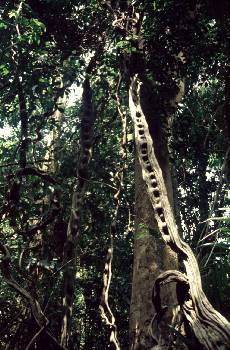
GALLERY OF LIANAS
Stefan Schnitzer: Liana Expert
All liana photos by Stefan Schnitzer
Stefan is a friend of ours at the University of Pittsburgh, who runs the
field data collection for Dr. Walt Carson's project on the effects of
insects and mammals on forest vegetation-- how much do they feed on and
what does it do to the open-ness of the vegetation. Stefan works part
of the year on BCI and on the nearby peninsula of Gigante. He has a
very interesting lifestyle. Here are his comments, and his own photos
of lianas in Panama at his study site. Notice how complicated the
tangles of lianas can be! Try to imagine searching for a silky anteater
(tapicara) in all these vines:

Photo by Stefan Schnitzer: Liana Expert

Photo by Stefan Schnitzer: Liana Expert

Photo by Stefan Schnitzer: Liana Expert

Photo by Stefan Schnitzer: Liana Expert
What do you do as a scientist?
Before I answer that, let me ask you a few questions. Did you ever
wonder
how tropical forests grow? How do they stay as forests and not turn
into
grasslands or fields? Do trees live forever? What happens when a
tree
gets
old and falls over? What grows in that fallen tree's spot? Well, as
a
scientist, my job is to answer questions like these. My main interests
are
in learning how tropical forests grow and why there are so many species
of
trees and lianas in tropical forests.
So how do tropical forests grow?
Most of the time, after a tree falls, little trees that are growing in
the
shadows of the big trees will grow up and take-over the spot of the
fallen
tree. But what I have found is that sometimes the little trees can't
grow
because they are strangled by lianas!
What are lianas?
Lianas are vines that are woody, like trees. But unlike trees, lianas
can't
stand-up on their own. They have to climb-up trees to get to the
sunlight.
Lianas are really neat plants and they are all over tropical forests,
twisting and twining around the trees. But sometimes lianas twist
around the
trees so much that they strangle the trees! When lianas strangle the
little
trees that are trying to grow-up under the fallen trees, parts of the
forest
can actually stop growing. Instead of new trees, the forest can become
a big
tangle of vines!
How long do lianas live?
How long do lianas live??? How many grains of sand are there on the
beach?
How many drops of water are there in the ocean? How many angels can
dance on
the head of a pin? When we know the answer to these questions, we may
know
the answer to How Long Do Lianas Live. Actually, this is a great
question!
All we know is that lianas live a long, long time, probably many times
longer
than trees. How do they do this? Well, my theory is that lianas are
superorganisms that slowly move through time and space. When a large
liana,
which can be over a kilometer in length and many hundreds of years old,
falls
from the canopy with a treefall, it will often stay alive and send out
new
branches that climb back up to the canopy. These new branches develop
their
own roots and each branch effectively becomes a new individual. These
new
individuals, although the cells are young, are really a part of the old
liana
that originally fell from the canopy. Therefore, some lianas, even
though
they may look young, may be thousands, or tens of thousands of years
old!
But until I get around to testing this theory, we don't really know how
long
lianas live. Another unanswered mystery of the rainforest!
Why is it important to know how tropical forests grow?
Scientists want to understand how tropical forests grow because we want
to
know how the natural world works. Understanding the natural world is
important for a number of reasons. First, knowing how plants and
animals
have evolved and coexist give us an idea of how the natural world works
and
our place, as humans, in that world. Second, human beings are having a
huge
impact on the world, and we are destroying tropical forests faster than
ever
before. If we ever hope to re-grow tropical forests we will need to
know how
they grow naturally.
How did you become a scientist?
I wasn't always a biologist. After I graduated from college I took a
job
writing computer programs with a computer company. But I realized that
I
didn't want to work in an office; I was more interested in learning
about
biology and the natural world. So I went back to school to study
biology.
In addition to learning about biology, I found that school is a lot more
fun
when you are interested in what you are learning.
Do you have any advice for kids who want to become scientists?
Yes ? I think that the best scientists are ones that are curious and
imaginative. If you are interested in learning how things works and you
have
curiosity and imagination then you have the potential to become a
scientist
Webmaster: Howie Pogorsky, howardira@home.com